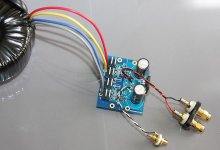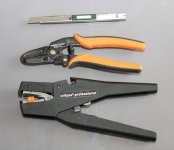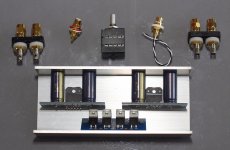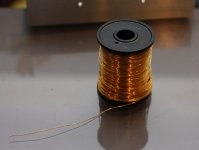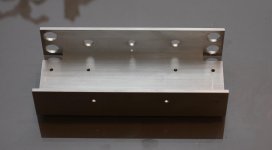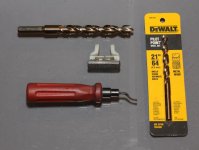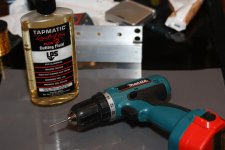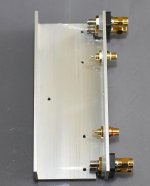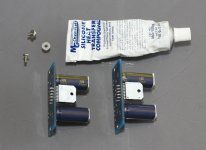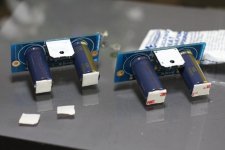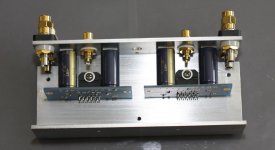Re: which transformer?
Partsexpress is more suitable choice. Go with a single Avel 250VA transformer, either 2 x 25V for 8 ohm speakers, or 2 x 18V for 4 ohm speakers.
I will post tomorrow more info how to wire single transformer.
gychang said:I will be following this thread, but I get confused on the transformer to get about 55W/ch in stereo from GC.
Anyone know the website for the appropriate transformer?, need cost-effective solution for the classic GC kit from Peter.
Any of the model here work?
http://www.apexjr.com/miscellaneous.html#Toroids
or here:
http://www.partsexpress.com/webpage...+toroid&search_type=main&WebPage_ID=3&x=0&y=0
do I need one or 2 transformers. (please say 1 😀 )
gychang
Partsexpress is more suitable choice. Go with a single Avel 250VA transformer, either 2 x 25V for 8 ohm speakers, or 2 x 18V for 4 ohm speakers.
I will post tomorrow more info how to wire single transformer.
Re: Re: which transformer?
My speakers are 8Ohms.
Is this the right one, I only need one right?
http://www.partsexpress.com/pe/showdetl.cfm?&Partnumber=122-625
I will be looking forward to your instructions.
gychang
Peter Daniel said:
Partsexpress is more suitable choice. Go with a single Avel 250VA transformer, either 2 x 25V for 8 ohm speakers, or 2 x 18V for 4 ohm speakers.
I will post tomorrow more info how to wire single transformer.
My speakers are 8Ohms.
Is this the right one, I only need one right?
http://www.partsexpress.com/pe/showdetl.cfm?&Partnumber=122-625
I will be looking forward to your instructions.
gychang
Yes, Avel Y236652 250VA 25V+25V Toroidal Transformer is right choice for 8ohm speakers.
If you don't mind spending a bit more, Avel Y236750 330VA 25V+25V is a good choice too.
If you don't mind spending a bit more, Avel Y236750 330VA 25V+25V is a good choice too.
Hi Peter -
My boards just arrived about an hour ago. The quality is very impressive. Thank You again.
How many questions do you want here on list vs. via PM?
I already have several 'dumb newbee' ones myself.
Bluto
My boards just arrived about an hour ago. The quality is very impressive. Thank You again.
How many questions do you want here on list vs. via PM?
I already have several 'dumb newbee' ones myself.
Bluto
Peter Daniel said:This concludes the assembly and we have two separate amp channels with separate bridge rectifiers. All is needed now is to connect 2 transformers (one per channel) as per schematic posted here: http://www.diyaudio.com/forums/attachment.php?s=&postid=1508798&stamp=1210694958 , connect the input (SG for ground, IN for signal input) and output ( OUT to positive binding post, OG to negative) and we have a working dual mono amplifier.
And this is how one complete amp channel looks when wiring is done. The transformer primaries are not connected yet, and I will explain it at later stages.
I usually use 26ga solid core wire for input signal and I never found a need for shielded cable. I normally don't even twist them, but it's a good idea anyway.
For speaker connections I use 19ga stranded wire.
See this table for American Wire Gauge Table:
http://cc.msnscache.com/cache.aspx?...-CA&lang=en-US&w=aa634ea9,7be5ab17&FORM=CVRE2
Attachments
By stereo version I mean the use of a single transformer powering both channels. You could still use two separate rectifiers boards, but depending on wiring it may produce hum in some systems, so I always stick with a single rectifier board when using one transformer.
For demonstration purpose, I will install all the boards inside 3 x 1.5" U-channel, 1.25" aluminum extrusion. For normal listening, this is enough to dissipate heat from the chips, and when things get hot, you can always attach it to larger aluminum panel.
I will show a version with a potentiometer, and without, so stay tuned.
For demonstration purpose, I will install all the boards inside 3 x 1.5" U-channel, 1.25" aluminum extrusion. For normal listening, this is enough to dissipate heat from the chips, and when things get hot, you can always attach it to larger aluminum panel.
I will show a version with a potentiometer, and without, so stay tuned.
Attachments
bump!!!
Hello Peter,
Great thread.
My buddy just ordered 2 3875 classic kits last week. I will be the builder. One kit for my studio monitors and one kit for his home stereo.
Can't wait for the rest.
I will be building 2 stereo versions.
I also had a question about internal wiring of the inputs/outputs and passive pot.
I use mogami 2549 mic cable it is OFC 22 gauge shielded.
DC Resistance
Inner Cond. 0.058W/m(0.018W/Ft)
Shield 0.013Ohms/m(0.004Ohms/Ft )
Capacitance at 1kHz, 20°C
K0 76pF/m(23pF/Ft)
K1 11pF/m(3.4pF/Ft)
I use this for all my interconnects and mic cable in my studio.
Would this be ok/good to use for the input and output (and pot) wiring?
Out,
Robert
p.s. you have amazing machining skills.
Hello Peter,
Great thread.
My buddy just ordered 2 3875 classic kits last week. I will be the builder. One kit for my studio monitors and one kit for his home stereo.
Can't wait for the rest.
I will be building 2 stereo versions.
I also had a question about internal wiring of the inputs/outputs and passive pot.
I use mogami 2549 mic cable it is OFC 22 gauge shielded.
DC Resistance
Inner Cond. 0.058W/m(0.018W/Ft)
Shield 0.013Ohms/m(0.004Ohms/Ft )
Capacitance at 1kHz, 20°C
K0 76pF/m(23pF/Ft)
K1 11pF/m(3.4pF/Ft)
I use this for all my interconnects and mic cable in my studio.
Would this be ok/good to use for the input and output (and pot) wiring?
Out,
Robert
p.s. you have amazing machining skills.
Hi,
That wire will be fine, if you don't mind working with shield.
As I mentioned previously, I never found the need for shielded wire and what I'm normally using is 26ga gold plated solid core copper. I only put teflon sleeving where the wire might come in contact with other wires, or chassis parts.I got it from a friend and he didn't disclose his source (most likely in UK)
Other alternatives can ba CAT 5 wire or Cardas uninsulated silver wire and Vampire Cast Copper Wire (available from Percy).
Kimber 19ga TCSS is also good for signal as well as DH Labs Revelation Series 23ga Solid Core Silver hook-up wire available from Partsconnexion.
That wire will be fine, if you don't mind working with shield.
As I mentioned previously, I never found the need for shielded wire and what I'm normally using is 26ga gold plated solid core copper. I only put teflon sleeving where the wire might come in contact with other wires, or chassis parts.I got it from a friend and he didn't disclose his source (most likely in UK)
Other alternatives can ba CAT 5 wire or Cardas uninsulated silver wire and Vampire Cast Copper Wire (available from Percy).
Kimber 19ga TCSS is also good for signal as well as DH Labs Revelation Series 23ga Solid Core Silver hook-up wire available from Partsconnexion.
Attachments
I use 6-32 screws to mount the chips, which requires 7/64 tap drill. For tapping, I always use a cordless drill gun and presently, Tapmatic fluid. For more info on tapping see those posts: http://www.diyaudio.com/forums/showthread.php?postid=69413#post69413
Attachments
As I mentioned previously, I never found the need for shielded wire and what I'm normally using is 26ga gold plated solid core copper. I only put teflon sleeving where the wire might come in contact with other wires, or chassis parts.I got it from a friend and he didn't disclose his source (most likely in UK)
Probably from here . 😉
Could be, thanks for the link.
The spool I pictured is 0.50MM GOLD PLATED COPPER WIRE SOFT 500GR, Ref: GP0500S-500
http://www.wires.co.uk/acatalog/cu_gp.html
The spool I pictured is 0.50MM GOLD PLATED COPPER WIRE SOFT 500GR, Ref: GP0500S-500
http://www.wires.co.uk/acatalog/cu_gp.html
I mount RCAs and binding posts first, and what you see is Cardas hardware. I use the cheapest RCAs: http://www.cardas.com/content.php?a...Female RCAs+(closeup)&content_id=6&part_id=32
and to me they sound better than more expensive types.
As to binding posts, I prefer low mass ACBP S: http://www.cardas.com/content.php?a...ding Posts+(closeup)&content_id=11&part_id=83
When spade connectors are to be used, Patented Binding Posts are my first choice (CPBP CRS): http://www.cardas.com/content.php?a...ding Posts+(closeup)&content_id=10&part_id=53
Please note that isolation washers are used to separate connectors from a chassis. With RCAs, I don't use the ground tab; the wires are soldered directly to metal body.
and to me they sound better than more expensive types.
As to binding posts, I prefer low mass ACBP S: http://www.cardas.com/content.php?a...ding Posts+(closeup)&content_id=11&part_id=83
When spade connectors are to be used, Patented Binding Posts are my first choice (CPBP CRS): http://www.cardas.com/content.php?a...ding Posts+(closeup)&content_id=10&part_id=53
Please note that isolation washers are used to separate connectors from a chassis. With RCAs, I don't use the ground tab; the wires are soldered directly to metal body.
Attachments
It's time to install amp boards now.
There are two types of LM3875 chips: isolated package (LM3875TF) and non isolated package (LM3875T). With the second one, isolation pad is required when mounting on grounded metal surface.
I use only isolated chips. Although pad is not required, one needs to apply heat transfer compound to improve heat dissipation from a chip to metal surface.
Don't use too much of that paste, only enough to fill the gaps. Also, the heatsink surface needs to be smooth and all burrs sanded out. I apply paste only to the chip, thighten pretty strongly; after half an hour realease the screw and this time tighten only moderately strong. Thick aluminum washer is used to improve contact.
There are two types of LM3875 chips: isolated package (LM3875TF) and non isolated package (LM3875T). With the second one, isolation pad is required when mounting on grounded metal surface.
I use only isolated chips. Although pad is not required, one needs to apply heat transfer compound to improve heat dissipation from a chip to metal surface.
Don't use too much of that paste, only enough to fill the gaps. Also, the heatsink surface needs to be smooth and all burrs sanded out. I apply paste only to the chip, thighten pretty strongly; after half an hour realease the screw and this time tighten only moderately strong. Thick aluminum washer is used to improve contact.
Attachments
- Home
- More Vendors...
- Audio Sector
- Commercial Gainclone kit- building instructions
